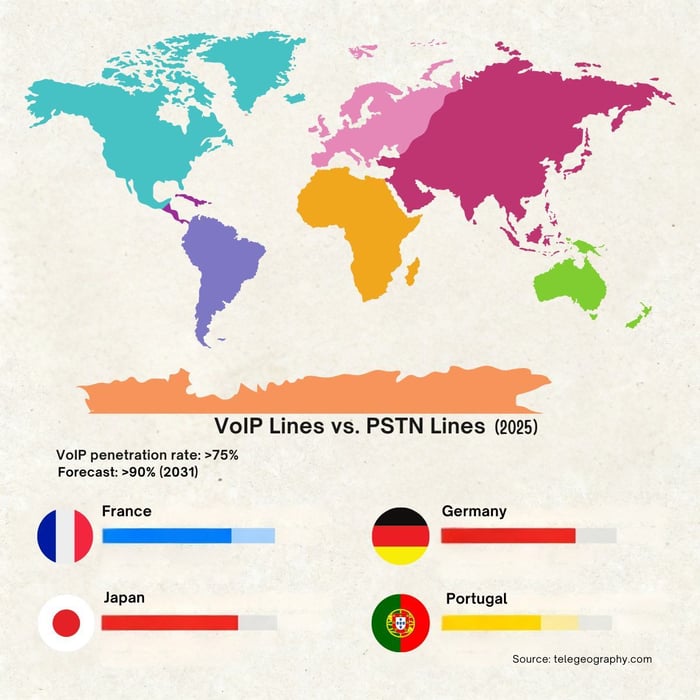Understanding virtual calls: basics, features, and benefits
Virtual calls, which allow individuals and businesses to communicate seamlessly over the internet,...
By: Otto Kolbe on Oct 23, 2024 3:00:00 PM

Your business phone system has an expiration date. Major telecommunications providers across the UK, Germany, France, Japan, and the United States have set firm deadlines to shut down traditional PSTN networks, some as early as 2025.
If your company still relies on analog phone lines, you're operating on borrowed time. But here's what most businesses don't realize: this forced migration isn't just an infrastructure headache.
It's an opportunity to eliminate communication costs, gain operational flexibility, and future-proof your business before legacy systems are disconnected.
The difference between virtual and traditional phone numbers isn't just technical; it's the difference between companies that adapt and those that scramble when their lines go dead.
The numbers tell the story: 75% VoIP penetration already achieved in leading markets by early 2025, projected to reach 90% by 2031. The migration is inevitable. The timing is your choice.
This guide breaks down everything you need to know: how each system works, what it costs your business to delay, and how to make the transition before you're forced to.
The transition from traditional to virtual phone systems isn't just a trend; it's a global infrastructure transformation happening right now.
By early 2025, countries at the forefront of digital communication, including France, Japan, Germany, and Portugal, have already achieved VoIP penetration rates exceeding 75%. Industry analysts project these nations will reach over 90% VoIP adoption by the end of 2031, marking the near-complete phase-out of legacy PSTN infrastructure.
Similarly, major economies like the United Kingdom, Australia, and the United States are accelerating the decommissioning of analog copper-line networks in favor of fiber-optic and IP-based voice services.
Telecommunications regulators across these markets have set firm deadlines for the PSTN shutdown, signaling that businesses still relying on traditional phone lines face an inevitable migration, whether planned or forced.
This global momentum reflects a clear reality: traditional telephony infrastructure is reaching end-of-life. Companies that proactively adopt virtual phone solutions gain competitive advantages in cost, flexibility, and scalability, while those delaying the transition risk operational disruptions and increased migration costs as legacy networks are decommissioned.
Understanding the fundamental differences between traditional and virtual phone systems is no longer optional. It's essential for future-proofing your communication infrastructure.

A traditional telephone number, also known as a regular, physical, or analog telephone number, is a communication method based on a direct physical connection. These numbers are linked to physical telephone lines and utilize the public switched telephone network (PSTN). They are typically connected to analog or digital telephones.
Traditional numbers operate over conventional telephone networks, which consist of complex systems of copper or fiber optic cables specifically designed for transmitting voice signals. Calls routed through these networks are subject to the provider's coverage limitations.
This type of telephone number has been the telephony standard for many decades, offering a reliable, though less flexible, means of communication compared to newer technologies like virtual telephone numbers.
A virtual phone number, also known as a VoIP or Internet phone number, leverages the vast capabilities of the internet. Unlike traditional phone numbers, these are not connected to a physical telephone line. They operate through the internet (VoIP) or cloud-based services and can be utilized on various devices, including smartphones, computers, and IP phones.
Thanks to internet connectivity, virtual phone numbers provide additional features such as call forwarding, voicemail, and call recording.
The benefits of a virtual telephone number are numerous and often surpass those of traditional phone numbers. The key advantages are outlined below:
1. Flexibility
🔸Virtual phone numbers are not restricted to a specific location or device.
Calls can be easily forwarded to various devices such as smartphones, tablets, or computers.
This is particularly advantageous for companies with a global presence or remote employees.
2. Cost Efficiency
🔸International call costs are significantly reduced or eliminated.
🔸Savings on expensive hardware and physical phone lines.
🔸Easy implementation and maintenance with low ongoing costs.
3. Extended Functions
🔸Features include call forwarding, voicemail, call recording, and automated greetings.
🔸Integration with other communication platforms like email and customer management systems.
🔸Facilitates professional customer service and more efficient communication.
4. Portability
🔸Users can retain their phone number regardless of their geographical location.
🔸Ideal for companies operating in different countries or frequently relocating.
🔸Ensures continuity and familiarity for customers and business partners.
These advantages make virtual telephone numbers an ideal solution for modern communication needs, offering flexibility, cost efficiency, and proven reliability.
International telephone numbers, available in over 60 countries, provide companies with a valuable opportunity to establish a global presence and communicate effortlessly with customers across diverse regions.
These phone numbers enable businesses to receive international calls without incurring additional roaming fees or international calling charges, ensuring seamless communication with clients and partners worldwide.
By utilizing international phone numbers, companies can enhance their accessibility and optimize customer service, creating a local presence in key markets. This approach facilitates smoother international telecommunication, fostering trust and customer satisfaction by giving the impression of a globally connected and customer-centric business.
Additionally, integrating these international numbers into your communication strategy allows companies to expand into new markets, maintain strong cross-border relationships, and improve their global competitiveness. With access to the appropriate calling codes for each region, businesses can streamline international calling processes and further enhance their reach.
Our international landline numbers enable you to receive calls from over 60 countries without extra roaming or international calling costs. This not only provides financial benefits but also strengthens your business relationships and reinforces your global presence.
Excellent customer service often begins with the first call, and 0800 numbers provide an ideal way to make this interaction as pleasant as possible for your customers. These toll-free numbers allow customers to contact you without worrying about costs, eliminating a significant barrier for many and encouraging engagement.
By offering 0800 numbers in over 30 countries, you can extend your international reach and ensure that customers receive the same high-quality service wherever they are in the world. This is especially beneficial for businesses with multiple branches and contact offices that strive to deliver a consistent and positive customer experience.
Take this opportunity to strengthen your customer relationships by offering a user-friendly and cost-effective communication platform that transcends geographical boundaries. Ensure your customers know you are always available for them, no matter their location, and set new standards in customer service that support your business goals and build trust with your target audience.
While traditional phone numbers provide a reliable communication method, they lack the flexibility and functionality of the innovative solutions offered by virtual phone numbers.
Virtual phone numbers, whether through a Cloud PBX or SIP Trunk, enable businesses to not only save costs but also greatly enhance their accessibility and professionalism. The numerous benefits, ranging from portability to advanced features, make them the ideal choice for modern businesses operating in a global and digital environment.
Furthermore, solutions like nationwide business numbers and international phone numbers in over 60 countries help maintain a consistent and professional image while optimizing customer communication.
0800 service numbers also break down barriers and offer excellent customer service by simplifying contact and increasing brand trust.
Overall, selecting the right phone number is crucial for creating a strong brand identity and ensuring smooth business operations. With the appropriate communication solutions, businesses are well-equipped to meet their customers' needs and succeed in a competitive market.
With Virtual-Call, you can optimize your communication strategy and enhance the customer experience. Our solutions are user-friendly and enable your business to operate flexibly and efficiently.
Contact us today to learn more about our customized communication solutions!
We connect you to the world! 🌍
Virtual calls, which allow individuals and businesses to communicate seamlessly over the internet,...
As the digital revolution continues to reshape the global business landscape, the imperative for a...
Are you intrigued by the integration of VoIP with mobile devices, or curious if any phone can...